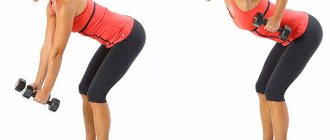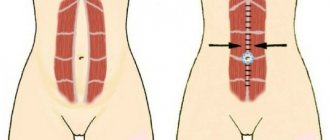Why does the belly remain after childbirth?
So, first, let's look at the causes of the problem. The main reasons are as follows:
- Enlargement of the uterus during pregnancy. The uterus is a muscular organ, which during pregnancy increases many times along with its growth. Immediately after birth, the uterus begins to contract, and its complete return to the normal size that was before pregnancy occurs 1.5 months after birth.
- Increase in fat layer in the abdominal area. Subcutaneous fat increases significantly during pregnancy. This is due to hormonal changes in the body. Both the number of fat cells and the fat reserves in them increase. Subcutaneous fat in the abdominal area, along with other changes, protects the fetus from external influences.
- Skin stretching. If the condition of the skin has not worsened during pregnancy and stretch marks have not formed, then the skin shrinks quite quickly, within a week after birth. However, if stretch marks appear - breaks in the fibers that make up the framework of the skin - the skin takes on a flabby appearance, quite often it contracts weakly, and excess skin is formed, hanging down in the form of a more or less pronounced “apron”.
- Weakness of the abdominal muscles. The abdominal press is not one muscle, but a whole muscle group. By structure, these muscles are striated, their contractions are amenable to human control, that is, these muscles can be controlled, given a load, therefore, their tone depends only on physical activity. If these muscles are not loaded, their tone weakens, and the stomach seems to protrude forward. The abdominal press is formed by the following muscles:
- The rectus abdominis muscle consists of two parts - right and left. It starts from the lower ribs and sternum and attaches to the pubic bone; the right and left parts are connected to each other along the midline of the abdomen, which is called the linea alba. The muscle bundles of the rectus abdominis muscle are transversely interrupted by 3-4 tendon bridges. Two bridges are located above the navel, the third is at the level of the navel, and the fourth (sometimes may be missing) is below the level of the navel. These tendon bridges of the rectus abdominis muscle give the effect of squares in physically trained people. When describing abdominal exercises for training the rectus muscle, exercises for the upper and lower regions are distinguished, since uniform distribution of the load on this entire muscle is impossible due to its size;
- The external and internal oblique muscles of the abdomen make up the lateral areas of the abdominal press, they are included in the work when bending to the sides, turning the body and circular movements. It is these muscles, when trained, that make the waist thin;
- The transverse abdominal muscle is located deepest, closest to the internal organs. It begins at the lateral walls of the abdominal cavity and runs along the middle of the abdominal cavity. This muscle tenses when the lower abdomen is pulled in. All exercises for the lower abdominal region train the transverse abdominis muscle, in addition to the lower rectus abdominis muscle.
Flat Stomach - The Basics of Proper Nutrition
Strengthening muscles is easy, but in order to lose excess fat you should try
. A flat stomach is first of all:
- Proper nutrition!;
- Physical exercises (aerobic and strength);
If you do abdominal exercises, you can strengthen your abdominal muscles. But, without cardio exercise and proper nutrition, your strong and toned abs will be hidden under a layer of fat. To get rid of fat, you definitely need to adjust your diet. Do not overeat, give up flour and sweets. You can calculate the number of calories you consume per day and the ratio of proteins, fats and carbohydrates.
You need to consume more protein foods, little fat, and get carbohydrates only from foods that contain complex carbohydrates and are able to supply the body with energy for a long time and gradually. Remember one rule: in the morning you can eat a lot of carbohydrates (sometimes it can be your favorite sweet!), but in the afternoon you need to give preference to protein foods with low fat content.
You can’t eat an hour before training, and after training you should also refrain from eating for an hour and a half; you can and should drink water. It is at this time that excess calories and belly fat will be burned.
Cardio loads
make the heart work harder, speed up the blood and burn fats and calories. Therefore, jumping rope, running, cycling, swimming, and energetic dancing help to lose weight and burn excess fat.
Some girls are afraid to do abdominal exercises because they don’t want to build up the abs and definition that men have. If you do exercises without weights, only with your own weight, it is impossible to pump up your abs and increase your muscles. Don't be afraid that exercise will make your waist look like a man's - a wide torso with prominent cubes. It is very, very difficult for a girl to pump up her six-pack.
But still, if you want not only a flat stomach, but also a thin waist with a beautiful curve, do not get carried away with pumping up the oblique and lateral abdominal muscles with weights, they are what make your waist wide
. It is enough just to tone them and strengthen them so that they tighten up and hold their shape tightly. This will make your waist thinner and sleeker. Muscles will not grow unless you do exercises with weights! But for a beautiful curved waist and flat stomach, you definitely need to do strengthening exercises for the oblique muscles.
Where to start restoring your figure?
Many women want to start getting back in shape immediately after giving birth. However, there must be moderation in everything. On the first day after natural childbirth, you can start wearing a postpartum bandage belt. It is advisable to use it throughout the entire postpartum period - for 6-8 weeks. The bandage helps contract the muscles of the uterus and anterior abdominal wall, as well as the skin, and thus helps restore the figure. It also helps with lower back pain, which is often a problem after childbirth. There are contraindications for wearing a postpartum bandage (certain types of sutures after cesarean section, kidney disease and gastrointestinal tract), so before using it you must consult with an obstetrician-gynecologist at the maternity hospital. In the first days after childbirth, some physical exercises that strengthen the abdominal muscles are allowed. Exercising in the early postpartum period will help you recover faster. Here is a set of exercises that can be performed the very next day after childbirth and throughout the entire recovery period (the first 6-8 weeks after childbirth) 2-3 times a day.
- Starting position: lying on your back. Inhale slowly, as you inhale, draw in your stomach, then exhale just as slowly, and as you exhale, inflate your stomach. Repeat 10 times.
- Starting position: lying on your back, bend your knees, feet on the floor shoulder-width apart, hands on your lower abdomen. Inhale slowly through your nose and then exhale just as slowly through your mouth, while making the sounds: “haaaaa,” trying to draw in your stomach as much as possible. While exhaling, lightly “help” him with your hands, moving your palms in the direction from the pubic bone to the navel. In this case, you should not press with your palms, but simply stroke your lower abdomen with your hands. Repeat the exercise 10 times.
- Starting position: lying on your side, knees slightly bent. Perform inhalations and exhalations as described in the previous exercise, combining them with stroking with your hands from the pubic bone to the navel. Repeat the exercise 10 times on each side.
- Starting position: lying on your stomach, arms resting on your elbows. You need to place a small, thick pad under your lower abdomen. It is important that there is minimal or no pressure on the chest. As you exhale, move your pelvis forward. While inhaling, return to the starting position. Repeat 10 times.
- Starting position: standing facing the wall, legs apart and slightly bent at the knees. Place your palms against the wall, and also press your forearms against the wall (elbows pointing down). Tighten your abs, as if bringing your right elbow to your left knee, then your left elbow to your right knee, without lifting your palms from the wall and your feet from the floor. No actual movements need to be made - only the abdominal muscles and back muscles are worked. As you inhale, relax your muscles.
What are the reasons for weakened abdominal muscles?
There are a number of reasons that can lead to weakened abdominal muscles. The most common provoking factors include:
- Lack of physical activity. If muscles are not used, they are partially replaced by adipose tissue. When performing any exercise, fatigue begins to set in faster. Over time, muscle weakening becomes more pronounced. In the absence of physical activity, not only the abdominal muscles weaken, but also others.
- Aging. When people, as they get older, stop doing things they used to do with ease, they believe that this is the norm. However, this is not at all true. The condition can be alleviated with regular physical activity.
- Infections. In this case, muscle fatigue is temporary. Further recovery may take a long period of time.
- Pregnancy. Muscle weakness always occurs during pregnancy. It usually does not disappear on its own after childbirth if no action is taken.
- Taking medications. The use of certain medications can cause muscle weakness and muscle damage. This is kind of a side effect.
- Bad habits. Bad habits such as smoking and alcohol abuse can lead to weakening of the abdominal muscles.
- Sleep disturbance. If a person is constantly lacking sleep, then muscle fatigue occurs over time. This negatively affects the condition of the body as a whole.
There are many other reasons for muscle weakness. When a problem appears, you need to immediately begin to fight it before the violation reaches an advanced stage. If the main cause of the disorder is the presence of any disease, then the need to consult a doctor cannot be ignored.
Upon returning from the hospital
After discharge from the hospital, you can perform the following simple exercises to strengthen your abdominal muscles:
- Lying on your back, alternately lower your legs bent at the knees to the right and left sides, repeat 5-10 times for each side.
- Sitting on the floor, slowly raise and lower your legs with a ball sandwiched between them, repeat 5-10 times.
- Lying on your stomach (with a pillow under your hips), alternately bend and straighten your legs, then alternately raise your straight legs, repeat 5-10 times.
In addition to exercise, daily walks with your baby in the fresh air are perfect for restoring physical fitness.
How to prepare for training
A tracksuit is the basics. It is more convenient to perform exercises in leggings, shorts and a T-shirt made of appropriate material. To get started, a mat and a list of exercises are enough. Over time, you can begin to practice additional loads. It is worth introducing new elements into training, then they will be more effective. The main load is dumbbells, which are well suited for other workouts.
Good idea - a gymnastic ball
, which is an ideal equipment for abdominal muscle training, squatting, bending and other exercises. It's good to have a hula hoop and exercise circle on hand. The latter device strengthens the muscles of the abdomen, arms, back and chest. It also improves physical fitness.
Let's continue training
2-3 months after giving birth, you can begin active abdominal exercises. The complex must include the following types of exercises:
- direct exercises (press press).
- lateral exercises (bending and twisting).
- circular rotations (torso rotations and quick crunches in a standing position).
When performing exercises, the following principles must be observed: training should be regular (preferably daily) and intense (start with one approach, gradually increasing the number of approaches to 4-5); do not use weights, as they do not make the stomach flat, but contribute to the appearance of relief in the abdominal muscles. Exercises should be performed carefully, avoiding excessive stress, especially on the spine. During exercises, you need to keep your abs in constant tension and monitor your breathing without holding it.
What is diastasis? Many women experience a separation of the rectus abdominis muscle after pregnancy. This discrepancy is called diastasis. In order to determine whether there is diastasis of the rectus abdominis muscles, you need to lie on your back and raise your straight legs 5-10 cm. If there is diastasis, a ridge forms in the midline of the abdomen, which can be seen or felt. Diastasis occurs during pregnancy, but can persist for 2 months of the postpartum period, gradually decreasing. It almost always goes away on its own.
Do the following exercises:
- Press press. Lying on your back, bend your knees and place your feet on the floor. Clasp your hands behind your head. Slowly lift your shoulders off the floor; it is enough to rise 15 cm from the floor. Effort - exhale through the mouth, relaxation - inhale through the nose. Repeat at least 10 times. You should not strain your neck muscles when performing this exercise.
- "Nut". Lying on your back, pull your knees to your chest. Hips, buttocks, shoulder blades should be pressed to the floor. Holding this position, tense your abdominal muscles, then stretch your legs, lowering them to the floor. Repeat 10 times.
- Lying on the floor, slowly raise your straight legs 45° from the floor, first alternately, then both together. The knees should remain straight. Socks on yourself. Effort - exhale through the mouth, relaxation - inhale through the nose. Repeat 10 times.
- "Bike". Lying on your back, make circular movements with your knees bent. Repeat 15-20 times.
- Twisting. Lying on your back, so that your lower back is pressed to the floor, bend your knees. Place your hands on your shoulders. Press your chin to your chest and lift your shoulders off the floor with a smooth “twisting” movement. The amplitude of the twists is very small, and the lower half of the spine should not rise from the floor. Slowly lower your upper back to the floor. Effort - exhale through the mouth, relaxation - inhale through the nose. Repeat 10 times in each direction.
How to train at home for girls
You can strengthen the transverse abdominal muscle not only in the gym, but also at home, without using additional sports equipment.
The pelvic bridge is one of the most popular exercises for strengthening the transverse abdominis muscle.
Abdominal training at home will only be effective if it is organized in accordance with a number of basic rules:
- It is necessary to perform the exercises daily if the girl is not engaged in a comprehensive program, but works out the abs separately, or 3-4 times a week as part of a full-fledged complex;
- the duration of a complex lesson should not exceed 60-80 minutes, and individual abdominal exercises should be performed within the range of 10 – 15 minutes;
- You can play sports both in the morning and in the evening, at the discretion of the athlete (you should focus on the biological clock - “night owl” or “lark”);
- Additional equipment that may be useful to a girl while working out her abdominal muscles at home may include a gymnastic mat, elastic bands or dumbbells of minimal weight (when performing exercises as part of a comprehensive workout);
- in order to prepare the muscles for the subsequent load, the athlete should perform a warm-up complex before the main part of the workout, regardless of the number of exercises included in it (the duration of the warm-up should not be more than 5-7 minutes);
- after the main part of the complex, it is recommended to perform a cool-down, during which the girl will be able to restore normal heart rate, as well as stretch the worked muscles to minimize pain in the post-training period;
- It is recommended to complete the work on the transverse abdominal muscle with breathing exercises (it will not only increase the effectiveness of the exercises performed by locally accelerating lymph flow and blood flow, but will also improve blood supply to the brain and heart).
Exercises for mom and baby
And here is a set of exercises that form a flat stomach, which you can perform together with your child. At the same time, the classes will benefit both the mother and the baby, who will be next to the mother.
- Diaphragmatic breathing. The mother lies on her back, the baby lies on her mother’s stomach, facing her. As you inhale, inflate your stomach, as you exhale, draw in the abdominal wall, hold your breath, hold your stomach in for several seconds. Repeat 10 times. The benefit of this exercise for the baby is that lying on his stomach prevents colic; the baby also learns to hold his head up and sit up.
- Mom stands on all fours, the baby lies on his back near her arms. As you inhale, bend at the waist and raise your head, while exhaling, arch your back, simultaneously lowering your head and tensing your abdominal muscles. Repeat 5-10 times. At the same time, the baby learns to follow the mother’s movements and turn his head.
- Mom stands on all fours, the baby lies on his back near her arms. Perform side squats: sit to the right, then to the left of the buttocks - twisting, sit on the right buttock, return to the starting position, then sit on the left buttock. Repeat 10 times.
A diet without exercise will lead to weight loss, but it will not give you a flat stomach.
The following exercises are for women with good physical fitness and coordination:
- The mother lies on her back, her legs bent at the knees, raised above the floor, her shins parallel to the floor, the baby lies on her tummy on her legs (on her shins) facing her. The child must be held by the back or by the arms. Keeping your shins parallel to the floor and raising your head and shoulders, reach with your right hand to the left half of the baby’s back, then with your left hand to his right side. Repeat 10 times.
- Starting position - as in the previous exercise. Straighten your legs first one at a time, then simultaneously. Repeat 10 times for each movement.
- Mom stands with her feet shoulder-width apart. Lean in the opposite direction from the baby. Repeat 5-10 times in each direction. You can take the baby in your arms.
Scissors
Lying on your back, stretch your legs, arms along your body. Lean lightly on your palms and press your lower back to the floor. Make sure that she does not leave the floor during the entire exercise. Raise your right leg straight up. Attach the left one to it. Lower the right one down to the floor and follow it with the left one. Start the next movement with your left leg up. Continue like this: always lift the leg that was last placed on the floor first.
Do 5 sets of 10-12 full cycles on each leg.
Recovery after childbirth without mistakes
Typical mistakes that women make after childbirth are:
- Using different diets to lose weight and lack of physical activity. Strict diets with limited calories and nutrients are contraindicated in nursing women, as they negatively affect lactation and, consequently, the health of the baby. It is necessary to eat rationally: avoid eating sweet, fatty, fried foods, use more fruits and vegetables, dairy products, and wholemeal bread in your diet. In addition, using a diet without exercise will lead to weight loss, the weight will normalize, but the stomach will not become flat. This is due to the fact that fat deposits are distributed unevenly (the fat layer is most pronounced on the abdomen, thighs, buttocks), as well as with reduced tone of the muscles of the anterior abdominal wall after pregnancy.
- Excessively early active physical exercise. You should know that active physical exercises on the abs are allowed only after 6-8 weeks if the birth was natural, and 10 weeks after a cesarean section.
If there are loads on the abdomen at an earlier stage, serious complications are possible: dehiscence of the sutures on the abdomen (after cesarean section) or perineum (after suturing perineal tears), prolapse of the walls of the vagina, uterus, increased divergence of the rectus abdominis muscle and, as a result, the formation of an anterior abdominal hernia walls.
It must be remembered that it is not enough to create a flat stomach - you must constantly maintain its shape in order to maintain and improve the results achieved.
Anna Mikhailova, general practitioner, Ph.D. honey. Sciences, Central District Hospital, Yamal-Nenets Autonomous Okrug, p. Krasnoselkup
When can you notice the first result?
Provided you regularly exercise at home, as well as follow the exercise technique, the first result in pumping the transverse abdominal muscle can be achieved after 3-4 weeks.
The speed of progress is affected by:
- initial data of the athlete. The higher the girl’s initial weight, the faster she will achieve results in the first months of sports. This is due to the fact that initially water begins to leave the body;
- physical training of the athlete (the better the girl’s physical shape, the more load her body can withstand, which means she will achieve results faster than a less prepared person);
- physiological characteristics (the rate of metabolic processes slows down with age, which explains the fact that women over 40 years of age find it more difficult than younger ones to pump up their abs, making them more prominent).
Exercises aimed at working the transverse abdominal muscle, like other physical activities, require the athlete to perform them regularly.
Due to physiology, fat on a woman’s belly is localized in the lower part, which means that it will be possible to achieve relief in this area as quickly as possible only by simultaneously playing sports and following the principles of proper nutrition.
What else do you need to strengthen your abdominal muscles?
Training will be many times more effective if you additionally adhere to other simple tips. Recommended:
- Healthy food;
- to refuse from bad habits;
- sleep about 8 hours;
- avoid stressful situations.
Training will only be effective if it is systematic. A one-time exercise will not give a positive result. It is also important not to forget about the need for an active lifestyle. After just a month of following all the recommendations, you can notice a pronounced positive result.
Causes of stomach distension
The main reason for stretching the stomach muscles is considered to be an irresponsible approach to organizing your diet - increased portions of food, frequent snacking, a love of foods that are difficult to digest. The consequence of this is the appearance of extra pounds.
According to statistics from the Russian Association of Gastroenterologists, about 90% of obese people have a stomach the size of which is comparable to a similar organ in cattle.
But in addition to poor nutrition, its size is also influenced by factors such as:
- chronic fatigue;
- the presence of inflammatory diseases;
- the body being in a state of stress.
Thus, in a person experiencing nervous tension or periodic fatigue, certain receptors that control the feeling of satiety fail. Most diseases are characterized by the presence of inflammatory processes that inhibit the process of digestion of food - it lingers in the walls of the stomach, not reaching the intestines in time. As a result, the patient, instead of the prescribed five daily meals, eats an increased amount in 1-2 meals, stretching the walls of his own stomach.
Symptoms
If a person has pulled the abdominal muscles, then the general symptomatic signs are as follows:
Click on the picture to enlarge
- Discomfort in the injured area.
- The occurrence of severe pain when trying to bend the torso or strain muscle tissue.
- Increased pain in a sharp direction when touching the affected area.
- Spasmodic phenomena.
- The occurrence of severe swelling and hematoma, which is typical for serious injuries.
If a microtear occurs in the tissues, then all the symptoms described above intensify significantly and begin to be pronounced.
Effect of liquid on the stomach
When wondering whether water stretches an organ, it should be noted that its volume should correspond to physical activity, climatic conditions, hormonal and metabolic processes, and the amount of food consumed.
Liquid helps dissolve and remove harmful substances from the body, so large amounts of food should be washed down with a significant amount of water.
On average, a healthy person needs 1.5-2 liters per day, but these norms are adjusted individually.
Water passes through the digestive tract in transit, so it does not linger in the stomach and cannot cause it to stretch. And even an increase in volume will only affect the metabolic process, but not the size of the organ. Therefore, what you should be afraid of is not an extra glass of liquid, but an addition to the portion, since water does not stretch the stomach.
Is it possible and necessary to reduce the size of the stomach?
You can quickly get rid of a distended stomach through surgery, suturing it to the desired size. Other methods are not so radical, but require more time and effort. These include diet adjustments, exercise, and medications.
Usually the stomach is reduced to lose weight. Such patients constantly feel hungry and feel unwell. Their organ is very stretched, and therefore they do not eat enough in standard portions, worsening their condition for satiety.











